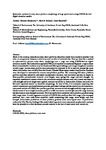Systematic analysis of rocky shore platform morphology at large spatial scale using LiDAR-derived digital elevation models
| dc.contributor.author | Matsumoto, H | |
| dc.contributor.author | Dickson, ME | |
| dc.contributor.author | Masselink, G | |
| dc.date.accessioned | 2017-04-20T15:31:13Z | |
| dc.date.available | 2017-04-20T15:31:13Z | |
| dc.date.issued | 2017-06-01 | |
| dc.identifier.issn | 0169-555X | |
| dc.identifier.issn | 1872-695X | |
| dc.identifier.other | C | |
| dc.identifier.uri | http://hdl.handle.net/10026.1/9102 | |
| dc.description | publisher: Elsevier articletitle: Systematic analysis of rocky shore platform morphology at large spatial scale using LiDAR-derived digital elevation models journaltitle: Geomorphology articlelink: http://dx.doi.org/10.1016/j.geomorph.2017.03.011 content_type: article copyright: © 2017 Elsevier B.V. All rights reserved. | |
| dc.description.abstract |
Much of the existing research on rocky shore platforms describes results from carefully selected field sites, or comparisons between a relatively small number of selected sites. Here we describe a method to systematically analyse rocky shore morphology over a large area using LiDAR-derived digital elevation models. The method was applied to 700 km of coastline in southwest England; a region where there is considerable variation in wave climate and lithological settings, and a large alongshore variation in tidal range. Across-shore profiles were automatically extracted at 50 m intervals around the coast where information was available from the Coastal Channel Observatory coastal classification. Routines were developed to automatically remove non-platform profiles. The remaining 612 shore platform profiles were then subject to automated morphometric analyses, and correlation analysis in respect to three possible environmental controls: wave height, mean spring tidal range and rock strength. As expected, considerable scatter exists in the correlation analysis because only very coarse estimates of rock strength and wave height were applied, whereas variability in factors such as these can locally be the most important control on shoreline morphology. In view of this, it is somewhat surprising that overall consistency was found between previous published findings and the results from the systematic, automated analysis of LiDAR data: platform gradient increases as rock strength and tidal range increase, but decreases as wave height increases; platform width increases as wave height and tidal range increase, but decreases as rock strength increases. Previous studies have predicted shore platform gradient using tidal range alone. A multi-regression analysis of LiDAR data confirms that tidal range is the strongest predictor, but a new multi-factor empirical model considering tidal range, wave height, and rock strength yields better predictions of shore platform gradient (root mean square error of predictions reduced by 5%). The key finding of this study is that large-scale semi-automated morphometric analyses have the potential to reveal dominant process controls in the face of small-scale local variability. | |
| dc.format.extent | 45-57 | |
| dc.language | en | |
| dc.language.iso | en | |
| dc.publisher | Elsevier BV | |
| dc.subject | LiDAR | |
| dc.subject | DEM | |
| dc.subject | Shore platform | |
| dc.subject | Rock coast | |
| dc.title | Systematic analysis of rocky shore platform morphology at large spatial scale using LiDAR-derived digital elevation models | |
| dc.type | journal-article | |
| dc.type | Article | |
| plymouth.author-url | https://www.webofscience.com/api/gateway?GWVersion=2&SrcApp=PARTNER_APP&SrcAuth=LinksAMR&KeyUT=WOS:000405051100005&DestLinkType=FullRecord&DestApp=ALL_WOS&UsrCustomerID=11bb513d99f797142bcfeffcc58ea008 | |
| plymouth.volume | 286 | |
| plymouth.publication-status | Accepted | |
| plymouth.journal | Geomorphology | |
| dc.identifier.doi | 10.1016/j.geomorph.2017.03.011 | |
| plymouth.organisational-group | /Plymouth | |
| plymouth.organisational-group | /Plymouth/Faculty of Science and Engineering | |
| plymouth.organisational-group | /Plymouth/Faculty of Science and Engineering/School of Biological and Marine Sciences | |
| plymouth.organisational-group | /Plymouth/REF 2021 Researchers by UoA | |
| plymouth.organisational-group | /Plymouth/REF 2021 Researchers by UoA/UoA07 Earth Systems and Environmental Sciences | |
| plymouth.organisational-group | /Plymouth/Research Groups | |
| plymouth.organisational-group | /Plymouth/Research Groups/Marine Institute | |
| plymouth.organisational-group | /Plymouth/Users by role | |
| plymouth.organisational-group | /Plymouth/Users by role/Academics | |
| plymouth.organisational-group | /Plymouth/Users by role/Researchers in ResearchFish submission | |
| dcterms.dateAccepted | 2017-03-14 | |
| dc.rights.embargodate | 2018-3-16 | |
| dc.identifier.eissn | 1872-695X | |
| dc.rights.embargoperiod | 12 months | |
| rioxxterms.funder | EPSRC | |
| rioxxterms.identifier.project | Waves Across Shore Platforms | |
| rioxxterms.versionofrecord | 10.1016/j.geomorph.2017.03.011 | |
| rioxxterms.licenseref.uri | http://www.rioxx.net/licenses/under-embargo-all-rights-reserved | |
| rioxxterms.licenseref.startdate | 2017-06-01 | |
| rioxxterms.type | Journal Article/Review | |
| plymouth.funder | Waves Across Shore Platforms::EPSRC |


